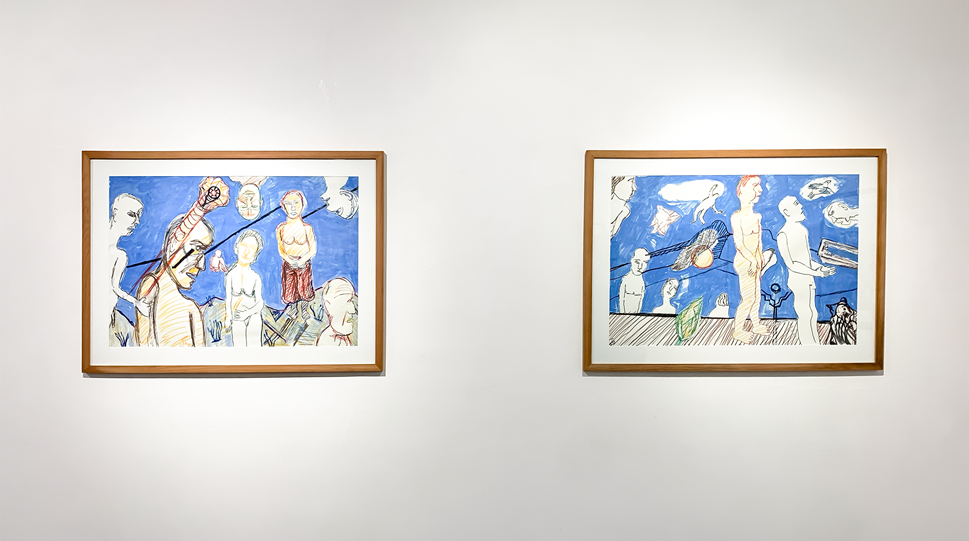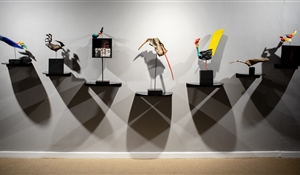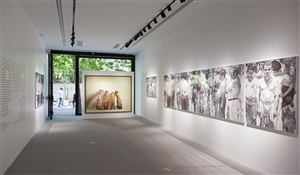"Skies"; A Review of Farshid Maleki's Solo Show at Hoor Art Gallery
30 Aug 2022Original text in Farsi by Pegah Rajamand
Translated to English by Omid Armat
Farshid Maleki's latest solo show titled "Skies" was held from June 10 to July 4, 2022, at Hoor Art Gallery. The paintings presented at this show are all created from 2020 to 2021 and have one feature in common; the smoothness of lines and surfaces. The jumbled lines in both outlines and surfaces add an expressionistic sense to the works and give the viewer a feeling of apprehension. This feature may be used to add a kind of movement and liveliness to the characters. Additionally, the position of humans and animals, sometimes depicted from different views and sometimes rendered like a shadow with their back to the viewer, reveals the emotional aspects accompanying the narrative in the works.

Farshid Maleki | Untitled | 2021 | mixed media on paper | 70 × 100 cm
With his usual expression in creating images, Farshid Maleki may be considered a painter who narrates distances. Like his previous works, while the characters have relationships, they are depicted alone and far from each other in his recent paintings. Although they have many visual communication properties in common, they appear bewildered in various situations. Some figures have entered the frame from the top, and others, in the corner, are looking at the sun or the moon. Such properties lead the viewer's attention out of the frame and create a world in which everything lacks certainty. The suspension that dominates this world makes the viewer follow the narratives of these characters and the way they exist.
The personages rendered on blue backgrounds in Maleki's recent works appear empty or white and have two semantic aspects; they are mostly men or women in different positions; sitting, standing, or withdrawn. We may conclude that Maleki has reduced the characters to their few psychological properties to describe their personalities. Such features, along with distortions applied to the appearance of the main subjects, have turned them into human-like or animal-like figures that maintain their distance from each other and vary in their distance from the painter and the viewer. Moreover, the narrativity of works increases with horizontal frames. In addition to creating a feeling of peace in the images, it controls the entrance, exit, and the viewer's field of view even when choosing which artwork to see.

Farshid Maleki | Untitled | 2020 | mixed media on paper | 70 × 100 cm
The blue surface interpreted as the sky in these works cannot be found in the logical placement of the horizon line or a specific viewing angle. Rather, it is the blue background reproduced in all of Maleki's paintings and is related to various other elements. Repeating, pervasive, and monochromatic blue skies in Maleki's paintings embrace all other elements and reveal their different shapes and colors. The repetition is not only visible in color but also in the compositions of the works.
The repeating blue gives the impression that the sky is blue everywhere. Addressing in multiple frames and uniform compositions the psychological features of characters, each wandering lonely even though they are positioned next to each other, may refer to the human relations in today's societies. On the other hand, with a closer look, we can detect a difference created with black lines applied as the last layer to some of the works. The artist seems to have formed a narrative at the heart of his works. An animal-like figure similar to a dog or a jackal jumps out and covers everything else at the moment of finishing the painting, like memories that we suddenly remember, giving us bitter feelings. Therefore, just like the unexpected appearance of a wolf at the end of a dream or nightmare, which gives us the utmost level of fear, the artist has invaded the frame in the final layers to complete the narrative strongly formed in his mind and convey the fear of being attacked by the creature.
The visual and personal features of the "Skies" series have constantly been present in Maleki's works since 1995. He prioritized lines in the process of rendering these images. These lines freely and instinctively accompany the artist's mind and hand. The smooth movement of materials like markers and pigment liners has helped the artist present the psychological conditions of the personages. Although the artworks seem to be easily executed, they refer, more than any other external references, to the artist's inner whispers in an intentional process of eliminating the dominant logic of the world and adopting the viewpoint of a child.

Farshid Maleki | Untitled | 2020 | mixed media on paper | 70 × 100 cm
The psychological aspects of the lines and surfaces in Maleki's paintings and the effect of childish painting on his works can be better understood according to his explanation.
A couple of years ago, I observed artworks of Hana, my daughter. Her works were pretty good, and I was influenced when I saw that she works so relaxed and without any concerns. She didn't fear that her work may not result well. She painted for the sake of painting and enjoying, and her works were always fine. Then, one day, I tried to do the same, and I noticed how hard it was. I put aside my feeling of responsibility and the urge to force my works to have an Eastern identity, a specific structure, or comply with any other limiting rules. I needed to get rid of that nosy person who stood behind me while working and kept telling me what to do or not to do to make my work purer. (1)
Therefore, regarding the purity of forms, colors, and lines, we may consider Farshid Maleki's behavior in creating images similar to self-taught artists who don't follow academic rules and principles. These artists create their works regardless of the art market. They don't produce artwork to be watched or criticized. They don't comply with the taste and criteria of mainstream art production. It should be noted that despite visual similarities between works by these artists and Maleki's artworks, there are many differences. He aimed to achieve purity in his paintings when he intentionally abandoned the principles he considered limiting. By suspending his human-like figures between the checkered pattern of the floor and the blue surface, the artist seems to consciously make his mental interests accompany his unconscious by depicting different psychological conditions, facial expressions, and body positions.
1."This may be how reality looks"…, Interview with Farshid Maleki, Herfeh: Naghash, 2001.






